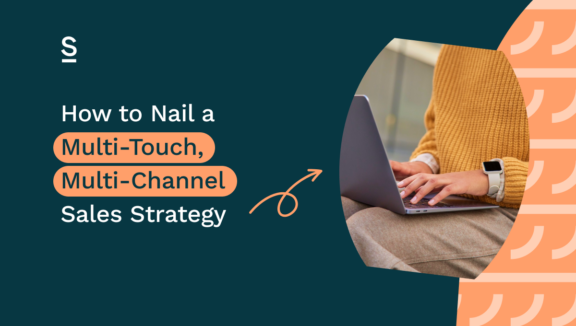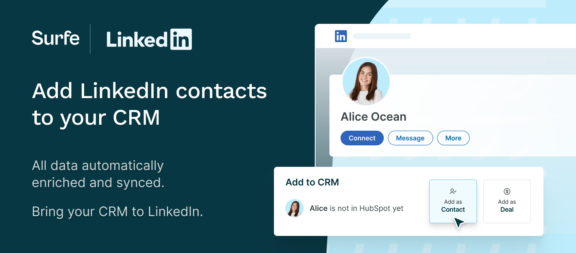How to Nail a Multi-Touch, Multi-Channel Sales Strategy

Want to understand what a multi-touch, multi-channel sales strategy is?
Cast your mind back a second.
Back way, way before you were born.
(ok, not that far back. A couple of decades maybe).
Sales were done over dinner. Over the phone. Maybe over email, if you were working for a *really* forward-thinking company.
Simple times, right? Now, sales are done everywhere.
You might find your dream prospect over email, over the phone, on social media, over text – even in real life (the horror!).
One interaction isn’t enough anymore. Think about all the interactions you have in one single day – everything from liking a post to answering a work email to texting your mum. Do you remember all of them? No?
Now, if you didn’t know us any better, you might think we’re saying that sales these days is really hard, really complex, and your prospects will never remember you.
And if you were just reaching out once, over one channel, we’d confirm that yes, that is what we’re saying.
Fortunately, though, sales in 2024 just requires a different strategy. A multi-touch, multi-channel sales strategy, to be precise.
The exciting thing about this strategy is that if you adopt it, you’ll stand out. 80% of sales are made between the 5th and 12th touchpoint, but 48% of salespeople never make a single follow-up attempt. Not even one!
Even better, there are plenty of tools you can leverage to help you. The right tools will simplify and enhance these strategies, so you’ll be onto a winner every time.
Ready? Let’s dive in.
Skip ahead:
- Understanding multi-touch, multi-channel sales strategy
- Key components of a multi-touch, multi-channel strategy
- Building an effective multi-touch, multi-channel strategy
- Tools and technologies to support your strategy
- Best practices for multi-touch, multi-channel sales
- Common challenges and how to overcome them
- Measuring success

Understanding Multi-Touch, Multi-Channel Sales Strategy
So, first things first. What is a multi-touch, multi-channel sales strategy?
Simply put, it’s the practice of reaching out to prospects multiple times, through multiple channels. That said – it’s definitely not a random approach, with a sprinkle of LinkedIn messages over the week and the odd phone call every month or two.
Instead, it’s highly planned and unique to your business. You’ll have specific touch points to use at specific times, and use all your channels together to create a prospect experience that they can’t ignore (and even better – won’t find overwhelming).
The benefits of a multi-touch, multi-channel sales strategy? We’re talking higher rates of customer engagement, lead nurturing that feels natural, and conversion rates that’ll make you an example for everyone else to follow.

Key components of a multi-touch, multi-channel strategy
Touch points will vary business to business, customer to customer, but broadly speaking, here are the common touch points used in a strategy like this:
Call: old school? Absolutely not! Any “guru” that tells you cold calling is dead is wrong. It’s often the most straightforward way to get your prospects on the phone – and get an answer out of them quickly.
Email: another classic – but no less vital. A quick email feels unobtrusive and allows you to send over additional media, too.
Social media: We’re talking about LinkedIn. Everyone is on there – for the same reason you are – and you can message your prospects directly and interact with their content too.
Events: events can be a great way of engaging with your prospects – whether they’re a SaaS event, a huge conference, or exclusive dinner. (fancy!)
Voicemail: another opportunity for you to stand out here. 74% of companies don’t leave voicemails. You should be!
So, you’ve got your channels. How do you put it all together in a cadence?
The exact combination and timeframe will be unique to your business – enterprise sales will have a different approach to SME sales, for example – but there are best practices you can follow.
SalesLoft has a great report here. Their top tips?
- Double touch on the first day – a phone call followed up with an email, for example.
- Leave breathing room – this is so, so important. Don’t make your prospects feel like you’re in the room with them (in a bad way). Give them space.
The more effectively you can integrate your channels, the more cohesive your strategy will feel – and something that feels natural rather than forced or overdone will appeal to your prospect too.
Building an effective multi-touch, multi-channel strategy
Time for the real nitty-gritty stuff: building your strategy. Here’s our approach:
Audience segmentation
Start by segmenting your audience. For example, you can divide it up based on:
- Role
- Behaviour
- Tiering
- Tech stack
- Workplace attributes
This approach allows you to personalise your outreach. For example, a finance director is likely going to have different pain points to an HR manager. Speaking to the relevant ones is going to generate far higher engagement.
Timing and cadence
SalesLoft has another nice tip here. Don’t worry too much about day or time. The only guarantee in sales is that if you don’t send any messages, you’re not going to get any responses. Just start and see what works.
That said – remember breathing space. Don’t enrage them into blocking you, or continue pestering if they’re consistently showing zero interest. Keep to a high number of touchpoints in the first 10 days, then peter off.
If you’re not getting anywhere (your strategy should have a specific cutoff point) then put them into a low-touch cadence – a once-a-month email newsletter, for example.
Channel consistency
Keep your messaging consistent no matter what channel you’re on. If you’re hitting your prospect with a new message each time, they’re not going to understand who you are or what you do – and then they’re not going to know to reach out to you or reply when the time comes.
Tools and technologies to support your strategy
The good news? Sales strategies have evolved, and tech has too. There are so many great tools you can use to support your multi-touch, multi-channel sales strategy.
CRM integration
It’s so important to integrate your CRM with your communication channels. After all, you need to make sure that every touchpoint is recorded. If someone else picks up the account, or you need a reminder of what this particular prospect’s last touchpoint was, you need to be able to access this data in your CRM.
Take Surfe, for example (hi 🙋). We integrate seamlessly with major CRMs, meaning every LinkedIn message you send is recorded as a touchpoint – whether that’s in HubSpot, Pipedrive or something else. No more missed opportunities, or accidental over-communication.
Automation tools
Multi-touch, multi-channel sales is (obviously) a bit more time-consuming than single-touch or single-channel sales – but you can automate your processes.
For email, tools like Woodpecker can help you send targeted emails en masse. Aircall can speed up the time you spend dialing numbers, while Cloudcall lets you send pre-recorded voicemails rather than recording one each time. As for LinkedIn outreach? Well, that’s where Surfe comes in (duh). We help you automate LinkedIn outreach with personalized AI templates, and keep track of it all for you too.
Analytics and data management
The cornerstone of any good sales strategy? No, we’re not talking about you (sorry).
The real answer is data. You should be tracking your every move to figure out what works and what doesn’t. It’s exactly the information you need to build out a great sales process playbook.

Best practices for multi-touch, multi-channel sales
Steal these tips to use – don’t blame us if your results are out of control!
Personalization
Speaking to a pain you know your prospect is suffering is a great rule of thumb – as long as you’re explaining that you have a solution, too.
The second level of multi-touch, multi-channel personalisation is to mention a conversation you’ve had elsewhere. For example, if you had a great interaction in a LinkedIn comments section, be sure to mention it in your email a few days later.
Engagement
Cold outreach that generates engagement will be relevant to a pain and straight to the point. No one wants to spend their time reading your life story – no matter how interesting it is. That said, make sure you’re adding a human touch (in other words, don’t sound like a robot). Adding a low-friction CTA to your first messages also works wonders – aim for a response, not a demo booked.
Warm outreach requires in-depth research – into companies, executives, anything you think might be relevant. You’ll want pre-prepared talking points and ways to handle any objections – and make sure to perfect your opening if it’s on the phone.
Remember, always listen to your prospect too. Only ask for the sale if they’re signalling that they’re the right fit.
Follow-up strategies
When it comes to following up, don’t try and guilt trip the prospect. Instead, keep it quick and upbeat – and professional. Don’t let your messaging go out of the window on touchpoint number five. Make sure you’re up-to-date with regulations too. If they’ve emailed an ‘unsubscribe’ message, for example, you need to action it straight away to avoid getting in trouble.
Common challenges and how to overcome them
Data management: make sure your contact data is accurate and up-to-date. There’s no point zeroing in on a prospect only to find they moved jobs two years ago. Our view? Your tool should automate this – there’s no need to rely on manual data inputting in this day and age.
Channel overlap: avoid redundancy and over-communication by keeping careful track of what’s been sent and when. Your CRM should track this for you – preferably without you having to do it manually.
Resource allocation: manage your resources efficiently across channels. Don’t put all your efforts into one (a common mistake if you write killer emails or are a natural cold caller, for example) and make sure that you have time to hit each and every touchpoint, on time.
Measuring success
Key metrics
Two things to think about when measuring success metrics:
Obviously you’ll have the metrics for each and every channel. Open rates and CTRs for email, reply rate for LinkedIn, and so on and so forth.
The second piece of the puzzle is how the channels perform against each other. Have you got the balance right? Is the data telling you to scale back on texting, and replace it with another email? After all, it’s not a multi-channel strategy if you’re viewing all your channels in silos.
Continuous improvement
Use the data you gather to improve your strategies. For example, if you notice a trend in how a particular buyer persona responds – how many touchpoints it takes, for example – use that to adapt your strategy.
If you’re getting nowhere with email – maybe your buyer spends all day out of the office – then dial (sorry) up your phone usage.
To analyse the data, we’d recommend looking at trends across different audience segments, using visualisation to make data analysis easy, and cross-referencing different data points to create a super accurate picture.
Make sure you’re being clear on why you’re looking at the data, and what you expect your insights to influence.
Inspiration
Need some inspiration? Take a look at PlayPlay, an online video creation solution. They have a killer multi-touch channel solution that keeps a balance between a human-first sales approach and managing to reach out at scale. Plus, the whole thing is super transparent and visible too. Well worth a look.
Let’s wrap it up!
Multi-touch, multi-channel sales is the key to your prospects’ hearts (and minds). By remaining cheerfully persistent over multiple channels, you can make sure your business stands out against all the rest.
Use the wealth of tools available to you today, track every move (yours, not your prospects’) and you’ll have that virtual handshake in no time. Easy peasy!

Multi-touch, multi-channel sales strategy? Simple.
Level up your LinkedIn messaging and keep track of everything you do without lifting a finger. Sounds to good to be true? Check Surfe out.
FAQs about multi-touch, multi-channel sales strategies
What is the meaning of a multi-touch sales strategy?
A multi-touch sales strategy is an approach to sales that involves reaching out to prospects more than once. This might get old if you only do it on one channel, like email, but if you make sure your touchpoints are spread across multiple channels you’ll be more likely to stick in your prospects’ minds, and pique their interest.
What is an example of a multi-touch sales strategy?
Here’s an example of a multi-touch sales strategy:
- On day one, call your prospect and then follow up over email
- On day two, call your prospect twice – once in the morning, and once in the afternoon
- On day four, connect with them on social
- On day five, call your prospect and follow up over email
- On day eight, leave them a voicemail
- On the final day, send a final email and move your prospect to a nurture email
What are the benefits of multi-channel selling?
Multi-channel sales strategies give you more opportunities to reach your prospect. Rather than hoping for a response on one channel, you’re much more likely to meet them on the channel that they are most receptive to, or active on. Sales teams that use multi-channel sales strategies should see higher conversion rates than those that don’t.
How to sell on multiple channels?
To sell on multiple sales channels, you’ll need to follow these best practices:
- Define the channels most appropriate to your business
- Keep careful track of touchpoints in your CRM
- Make sure your data is accurate, and up-to-date
- Use data to continuously improve your outreach process
What is a good sales strategy?
A good sales strategy in 2024 is to have a multi-touch, multi-channel approach. Rather than reaching out to a prospect once, on one channel, a multi-channel approach gives a sales rep more chances to interact with their prospect. It’s important to make sure that this approach isn’t overwhelming for the prospect. To do this, a good multi-channel sales strategy should be well-planned, with plenty of breathing space in between contacts.


